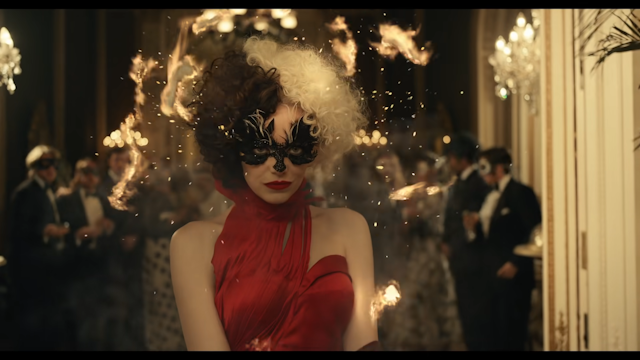This article contains spoilers for the film Cruella.
Cruella, Disney’s live-action movie about the early years of fictional Dalmatian hater Cruella de Vil, has joined a trend of films that seek to invite sympathy for the devil, specifically the cartoon and comic-book villains of our childhoods.
In theory, Cruella presents a difficult question: what kind of tragic backstory could lead the audience to sympathise with a villain who wants to kill and skin puppies? In practice, however, this gorgeous yet predictable film tells us very little about the psychology of evil - but a lot about the state of today’s Hollywood.
Critics expressed similar anxieties about Joker (2019) humanising a villain that had in previous films “just wanted to watch the world burn”. But if anything, Cruella, a cinematic paint-by-numbers, shows that we have always been fascinated by stories about the origins of evil.
The film can be described as a collection of tired old story beats in a dazzlingly fashionable trench-coat. Like Elphaba from Wicked, young Estella (Cruella’s real name) is marked from the start as an outcast by her unnatural appearance. Brilliant but troubled, she is bullied by her classmates, much like the evil genius Megamind in the animated film of the same name, or like Stephen King’s firestarting teenager Carrie.
Estella’s fall begins with the murder of her kindly mother by a narcissistic fashion icon called the Baroness. Like Walter White from Breaking Bad, Estella assumes a dark alter ego, Cruella, to hide behind as she exacts revenge. Like Star Wars’ Luke Skywalker, she then discovers her nemesis is actually her biological mother. And like countless comic book villains, she seals her transformation with a faked death and a name change, declaring that “Estella” is dead and only Cruella remains.

Notably missing are any actual evil deeds on Cruella’s part. Not one person, never mind a dog, is really hurt in the film. Cruella agonises over being mad and bad, but her villainous actions amount to disrupting fashion shows. When she has the Baroness imprisoned at the climax, it’s for a crime her enemy did indeed commit.
At one point, the baroness is convinced that Cruella has killed and skinned her three dalmatians, but this turns out to be a ruse and Cruella adopts the dogs as pets. This version of Cruella isn’t apologism or revisionism: it’s practically a movie about a different character.
The Hollywood ‘universe’ effect
More than a story about why contemporary audiences are drawn to villains, Cruella and Joker tell us a story about how major Hollywood studios deal with changing audience and market conditions. The first trend they reveal is the drive to create expanded story-worlds based on existing properties.
Hollywood today is ruled by “universes”: the Marvel universe, the Star Wars universe, the worlds of Harry Potter or Lord of the Rings. When we as media consumers are surrounded by a huge number of channels and choices, making those choices easier by offering us more of what we already know and like is a surefire way for producers to stand out and reduce the risk of a new film flopping.

Much like the backstories told in films like Solo (2018) or the Fantastic Beasts series, Cruella offers a glimpse at a previously unexplored corner of a known and beloved story. This production strategy turns linear stories with defined beginnings and ends into vast worlds that audiences can keep returning to.
The choice to tell darker, more mature stories that explore the inner worlds of villains reflects a bid by studios to expand their audiences. A key target audience is adults who grew up watching the 1989-1999 “Disney renaissance” films including The Little Mermaid (1989), Beauty and the Beast (1992) and The Lion King (1994). Studios are eager to appeal to this group both as parents of the children now buying toys and happy meals and as consumers in their own right.
We see 80s nostalgia throughout the popular culture of the last 15 years, from Stranger Things to the recent remakes of animated classics She-Ra and He-Man. By promising to tell untold stories and answer unanswered questions, adult re-imaginings draw in fans who have spent years revisiting the originals.
These darker and more sophisticated films also aim to achieve prestige and cultural recognition for for genres normally deemed lowbrow or juvenile: super heroes, fantasy and children’s animation. By purporting to tell morally complex and psychologically realistic stories, studios such as Disney aim to expand and enhance their brands - a particularly important strategy for competing in the content streaming market.
Research shows that prestigious original content that appeals to an upmarket adult audience is a major attraction for platforms like Netflix. With its complex long shots and its glorious costume design, Cruella is full of cinematic showing-boating - just what the Disney+ streaming service requires for its own coming of age.
Few things are more natural than revisiting the things from our childhoods we used to accept without question. Telling Cruella’s story in shades more grey than black and white is no different. What the trend reflects is less a sudden cultural interest in sympathising with villains, and more studios’ desire to keep hold of a young audience that is now all grown up.

